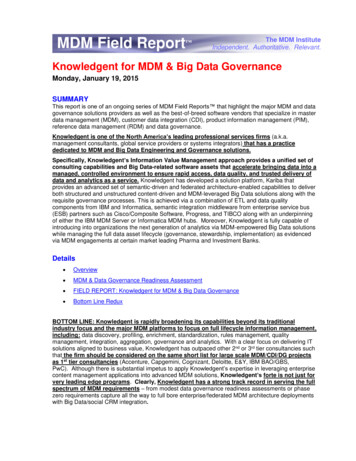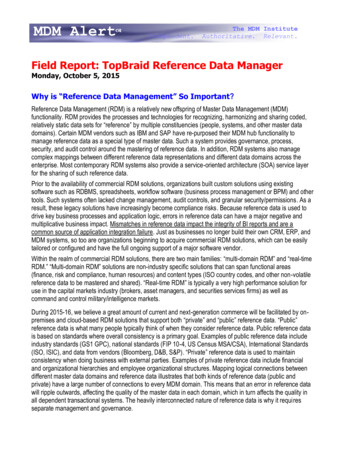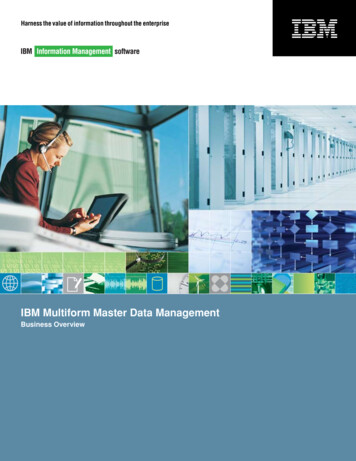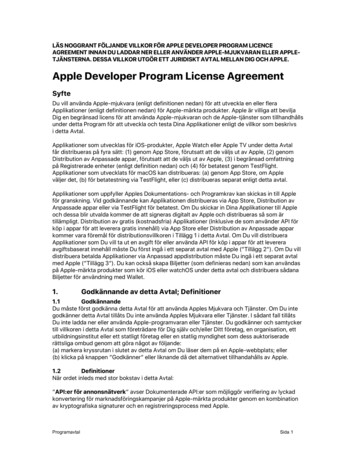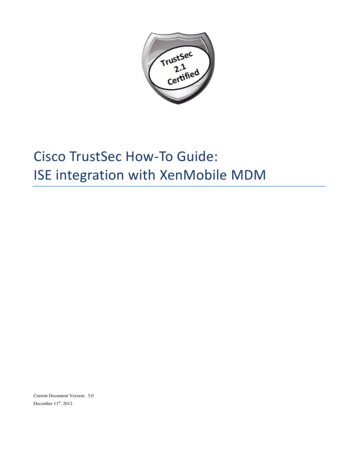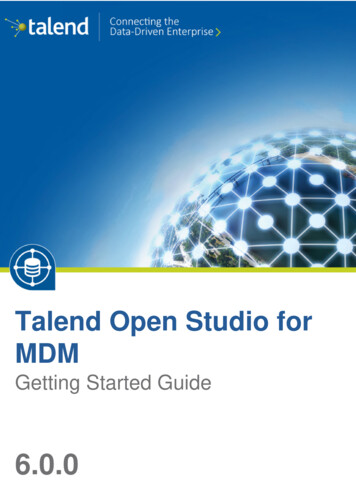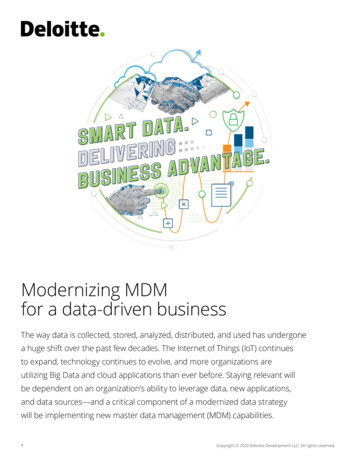
Transcription
Modernizing MDMfor a data-driven businessThe way data is collected, stored, analyzed, distributed, and used has undergonea huge shift over the past few decades. The Internet of Things (IoT) continuesto expand, technology continues to evolve, and more organizations areutilizing Big Data and cloud applications than ever before. Staying relevant willbe dependent on an organization’s ability to leverage data, new applications,and data sources—and a critical component of a modernized data strategywill be implementing new master data management (MDM) capabilities.1Copyright 2020 Deloitte Development LLC. All rights reserved.
The need forMDM modernizationHistorically, MDM has been viewed as a back-end hub in the “huband spoke” architecture, where utility was tightly linked to integrationcapabilities. However, MDM is being increasingly used to help deliverbusiness value across the customer journey. A modernized MDM platformis also required to enable critical back-office processes such as:Enable quote-tocash processeswith governed product masterdata to keep up with the pace ofnew product/feature introductionInform pricing /discounting decisionsduring quoting and/or renewals,based on customer lifetime value,current usage/adoption and pastbuying patterns across channelsHolistic view ofcustomer interactionsProvide customerknowledgeand NPS scores across products/services,supplemented by sentiment analysis ofsocial media, provided to customer successteams to engage with customers posingrisk of attrition and during renewalsfor white space analysis, leadingto personalized engagement andcross-sell/upsell opportunitiesA modernized MDM platform is also required to enable critical back-office processes such as:Perform trusted financial andmanagement reporting by offeringbusiness units/functions the ability tocreate, enrich, and approve financialmaster data and hierarchies (e.g.chart of accounts, cost centers, etc.)Provide a “clean room” facilitySupporting complex regulatoryusing multi-tenant cloud MDMpolicies that continue to evolvewith big data storage for analysis(e.g. GDPR, global trade compliance,of customer overlap and otherdenied party screening, etc.)analytics prior to M&AProvide a common templateEnabling the back officeof master and reference datawith governed product mastermappings to support coredata to support producttransformation projects and M&Aprofitability reportingby insulating downstream processesfrom upstream system/data changes2Copyright 2020 Deloitte Development LLC. All rights reserved.
In short, modern MDM and its differentiated capabilities can help organizations with:Customer engagement and experienceBetter engage with customers through real-time interactions aided by relevant and accurate informationIncreased business valueRealize more business value by helping business users make faster decisions through collaboration and visualizationOperational efficiencyReduce TCO by operating more efficiently with an intelligent and scalable architectureComponents of a modern MDM platformDespite significant investments in MDM technology and resources, many companies fail to realize the benefits. This can bea result of manyfactors, like a data explosion that leads to productivity issues or new business needs that emerge in a digitalworld. There are specific features that can provide this required functionality and qualify an MDM platform as modern:Visualization and smart searchFront-office is becoming more “data aware” and is increasinglyengaging in data stewardship responsibilities such as managingcustomer hierarchies or complex product taxonomies. A highlyconfigurable/intuitive UI and input-based dynamic searchcapabilities help with business adoption of these tasks.Microservices architectureAs the number and variety of business capabilities and data domainssupported by MDM increases, the case for MDM to be built ona microservices architecture becomes stronger—for example,a reference data microservice can be different from a customerdata microservice, both of which can expose different API’s andscale differently or be enhanced without impacting the other.Cloud/hybrid environment enablementOrganizations are increasingly moving to the cloud for variousbusiness applications. Hybrid MDM solutions are required to provideinteroperability across common cloud platforms in the value chainand on-premise applications. It enables users of cloud solutions toleverage their data and data management assets better and easesthe transition to cloud for on-premise-based organizations.Business and governance process orchestrationBusiness users need to collaborate effectively across the enterprisewhen it comes to creating and managing master and reference data.This data drives key business processes such as marketing campaigns,pricing, and customer and vendor compliance. Modern MDMcapabilities like highly customizable workflows, voting/ranking/ chatfeatures, mass maintenance, and machine learning-enabled guidedworkflows that recommend potential actions to users can greatlyenhance productivity.3Machine learning and AIIT and business functions can gain enhanced operationalefficiency and a reduction of operating expenses throughautomation of traditional data management tasks. Machinelearning-driven automated stewardship reduces datamanagement efforts and costs by constantly learning from,and emulating, the actions of a human data steward.Richer/deeper relationshipsCustomer-facing personnel and marketing analysts canexplore relationships and get a richer view of a customer’sproduct portfolio for mass personalization. Understandingcomplex customer hierarchies is critical in making pricingdecisions during deal management. To meet businessneeds, MDM should be able to handle extremely highvolumes on a Big Data platform and leverage NoSQL/key-value stores to provide richer and deeper networkrelationship views for intuitive exploration.Digital insightsBusiness users need to be able to better understand theinfluences from new digital footprints across social media,blogs and ecommerce sites to get in front of customerissues and engage in real-time market feedback. This callsfor an intelligent analysis of customer sentiment from thesesources and integrating it back to a Customer 360 portal todeliver the right action at the right point of interaction.Copyright 2020 Deloitte Development LLC. All rights reserved.
MDM andthe cloudAs mentioned, one of the critical elements of a modern MDM strategyis the ability to integrate and maintain data integrity across a mix of onpremise and cloud application landscape. Leveraging the cloud enablesMDM to perform as a nimble hub. It can provide faster business access,collaboration, and the on-demand scalability required when adding newcloud sources or Data as a Service (DaaS) feeds for data enhancement.The cloud strategy should not be underestimated in its importance. Itshould define the overall MDM modernization strategy and is central toproviding better business value and reducing total cost of ownership.When starting the journey to the cloud, organizations need to take intoconsideration all the data distributed across business units, regions,applications, data feeds, and data lakes. It’s not always necessary orwise to overhaul all data storage and move it to the cloud, and manyorganizations implement a hybrid approach, with some applicationsand data sets hosted on-premise and others existing in the cloud.An important component of an end-to-end MDM platform is theability to manage data repositories, whether in-cloud, on-premise or inhybrid environments, providing a quick and easy way to find, prepare,cleanse, enrich, master, govern, and protect enterprise data.Combining MDM with cloud and data lake strategies can drive a wide range of positiveoutcomes from data professionals and business users, including the ability to: Understand customer needs and pattern injust seconds, using a graph-based processingengine to match and relate even more datato deliver a more comprehensive view ofcustomers and other business-critical entities Enable smarter data discovery, automatingidentification and classification of business entities Improve self-service empowerment by facilitatingaccess to trustworthy data without reliance on IT Provide automatic concurrency scalingmeeting fluctuating data volume andcomputing demands triggered by an increasingnumber of inbound/outbound interfacesthat support various business processes Maximize extensibility to new data sources,creating custom metadata scanners for fastand easy access to custom data sources suchas legacy databases or bespoke applications Quickly achieve Customer 360 view andreduce TCO by leveraging cloud capabilities Maximize extensibility to new applications,supporting a metadata repository for easyaccess to custom web portals, workflowbased systems, and reports4Copyright 2020 Deloitte Development LLC. All rights reserved.
Key considerations forMDM modernizationTen years ago, few could have foreseen the emergence of data lake technologies, the impact of social media, the demandfor BYOD (bring your own device) capabilities, or the rise of the “citizen data scientist.” The challenges we will face in thenext 10 years are even more unknown, as the pace of change is accelerating. In such an environment, perhaps one ofthe most critical considerations when thinking about MDM is the flexibility of the platform to adapt and expand.Whether moving into true enterprise MDM for the first time, consolidating multiple masters due to M&A activity, or considering an upgradefrom an older MDM platform, organizations can now take advantage of next-generation capabilities through recent innovations in MDM.In addition to ensuring that the MDM solution provides the advanced capabilities mentioned,a few points to consider during your modernization effort are:Define a pragmatic and phased MDMroadmap that delivers incrementalbusiness value by moving the solutionup the maturity curve (e.g. domainsmastered, DQ/integration capabilities,business processes enabled, etc.).Focus on addressing master datagovernance roles/responsibilitiesand business process changes requiredto ensure that MDM investmentscontinue to deliver expected valueonce solution is operational.Leverage operational metrics anddashboards to monitor data qualitytrends, policy compliance levels, exceptionremediation rates, and adherence to SLAsdefined for fixing master data specificto transaction processing fallouts.Ensure that the MDM solutionmeets your InfoSec policies and hascertifications that include application,data-centric, and cybersecuritycontrols in place to protect yourdata at rest and in motion.Assess if the MDM solution integratesseamlessly with enterprise and cloudapps, and with capabilities such asreference data management, metadatamanagement, data governance, andexternal data providers such as D&B.Another element of MDM modernization to consider is that MDM initiatives can bedaunting in size and complexity, as they can require substantial investment in termsof resources—specifically money, people, and time. Fortunately, MDM software haskept pace, and newer MDM architectures such as domain-specific applications andend-to-end capabilities (those that combine data integration, data quality, businessprocess management and data as a service) have helped lower initial costs. Flexibilityin implementation styles can also enable organizations to customize their MDMinstallation and expand as needed. What was once considered optional is now tablestakes for organizations moving to customer-centric, modern digital ecosystems.5Copyright 2020 Deloitte Development LLC. All rights reserved.
The MDM journey withDeloitte and InformaticaOver a decade of experience delivering the industry-leading MDM technologyDeloitte works with clients to provide guidance and assistance across the entire MDM journey—from strategy through execution tomanaged operations. We can help companies improve business performance and derive value from their data assets by leveragingMDM technology, including Informatica Cloud and Informatica MDM. We differentiate ourselves by delivering MDM solutions thatare customized to meet each client’s unique business needs, and we can help maximize ROI from their MDM investments.Deloitte’s MDM Elevate is an accelerator that augments Informatica’s data management tools with Deloitte’s industry-leadingpractices and cognitive data management assets. The pre-configured solution allows clients to unlock several benefits that aretypically constrained or prohibited due to additional integration and development efforts required between MDM and a data platform(e.g. Data lake, data warehouse). Benefits like the application of big data processing, machine learning, and graph visualizationscan be enabled and establish a foundation that makes the total customer and product view a reality from the get-go.MDM Elevate is customized with data models catering to specific industries and sectors to jump-start development and save up to 30-40%on build effort. It reduces ‘cost of quality’ by using standardized and reusable code library that has been built based on leading practices,developed through multiple implementations over the years by Deloitte. The solution has been further elevated with next-gen socialmedia feeds, sentiment analysis, cognitive data stewardship and a data enrichment bot, and can be deployed on-prem or on the cloud.MDM Elevate can be used to demonstrate “art of the possible” during assessments, accelerate adoption during and postimplementation, and allows focus on developing unique client specific functionality and integrations. With pre-configuredintegrations with Informatica’s Axon (data governance) and Customer 360 Insights, it provides an end-to-end data managementand analytics solution from governance to master data management to generating actionable customer insights.Together with Informatica, Deloitte’s MDM solutions are designed to scale and evolve with modern architectures. We help our clients to increaseadoption of master data across the enterprise and deliver value directly to business users without sacrificing data security and compliance.Companies who have employed MDM solutions to supportcustomer centricity initiatives are better able to:Building a modernized MDM platform tocapture the value of marketing data offers ITorganizations many benefits, including: Create an authoritative, 360-degree view of MDM entities forcollaboration and consistency across internal teams, businessunits, departments, geographies, and ecosystems Enabling a self-service culture ofanalytics and innovation Grow and retain customers, capitalizing on cross-sell and upsellopportunities with greater personalization and relevance Reducing boundaries and improvingcollaboration between IT and the business Build more robust personas and more precisely segment and targetcustomers, boosting marketing campaign performance Strengthening enterprise scalability and security Improve employee productivity by exposing accurate business entityinformation (i.e. customer, product, supplier, etc.) and leveragingtemplates that speed time to market and offer operational efficiency Reduce the long-term cost of information delivery byoptimizing ongoing enterprise data management Managing governance and settingstrategies for success Taking your MDM journey to big data, thecloud and understanding when—andhow—to use a hybrid approach Streamline mergers, realize M&A synergies faster,and reduce risk to reap maximum returns Power big data analytics initiatives with clean, consistent data to extractactionable information from the data and improve critical decision making6Copyright 2020 Deloitte Development LLC. All rights reserved.
The Deloitte and Informatica allianceThe Deloitte and Informatica alliance combines Deloitte’s experience in information management with Informatica’s industry-leadingsoftware. We bring an extensive set of capabilities that involve reporting applications, portals, information delivery, and basic as well asadvanced analytics—all grounded in a deep understanding of the business issues that drive the industries and sectors we serve.Our goal is to help companies unlock the value buried deep within their data. With more than 3,000 practitioners experienced inhelp clients make it happen.AboutAboutDeloitte provides industry-leading audit, consulting, tax, andadvisory services to many of the world’s most admired brands,including 80 percent of the Fortune 500. Our people workacross more than 20 industry sectors with one purpose: todeliver measurable, lasting results. We help reinforce publictrust in our capital markets, inspire clients to make their mostInformatica is entirely focused on data because the worldruns on data. Organizations need business solutions arounddata for the cloud, Big Data, real-time and streaming data.Informatica is the world’s number one provider of datamanagement solutions in the cloud, on-premise, or in a hybridenvironment. More than 7,000 organizations around theworld turn to Informatica for data solutions that power theirbusinesses. For more information, visit www.informatica.com.the way toward a stronger economy and a healthier society.largest global professional services network, serving ourclients in the markets that are most important to them.For more information, please contact:Scott HolcombPrincipalDeloitte Consulting LLPMobile: 1 312 841 1220sholcomb@deloitte.comSara HennesseyAlliance ManagerDeloitte Consulting LLPMobile: 1 773 425 6990shennessey@deloitte.comPrathamesh KubalSenior ManagerDeloitte Consulting LLPMobile: 1 818 748 5730Email: pkubal@deloitte.comNansi StretcherGlobal Alliance DirectorInformaticaMobile: 1 214-683-4265nstretcher@informatica.comNetwork shall be responsible for any loss whatsoever sustained by any person who relies on this communication. As used in this document, “Deloitte” means Deloitte Consulting LLP, a subsidiary of Deloitte LLP. Pleasesee www.deloitte.com/us/about for a detailed description of our legal structure. Certain services may not be available to attest clients under the rules and regulations of public accounting.Copyright 2020 Deloitte Development LLC. All rights reserved
Another element of MDM modernization to consider is that MDM initiatives can be daunting in size and complexity, as they can require substantial investment in terms of resources—specifically money, people, and time. Fortunately, MDM software has kept pace, and newer MDM architectures such as domain-specific applications and

